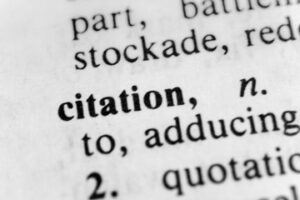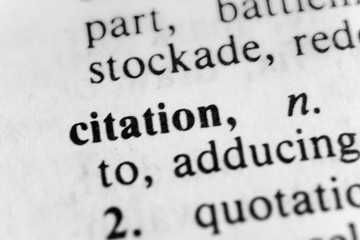A citation is a way to tell your readers where you got your information. It also helps your reader understand how your work fits into a larger conversation.
The citation style you use depends on your discipline and the formatting guidelines. Most scholars follow MLA or APA styles. For a list of common citation styles, see PCC’s Citation Style Guide. Click Here to learn more.
Citations are a way of giving credit and showing your readers where you got your information. In addition, they help you avoid plagiarism by allowing others to see where your ideas come from. They also show your readers how much research you have done for your work. Citations can be used in any type of writing but are most often found in research papers and academic essays. They are usually listed at the end of a paper on a bibliography or Works Cited page.
A basic citation includes the author, title, and publication information of the source. If the work is in a book, the author should be listed first, and then any additional authors should be separated by commas. If the work is in a periodical, it should include the title of the article and the day, month, and year of publication. If the work is online, you should include the URL or DOI. The citation should be indented one-half inch from the left margin.
If you want to be more specific, use the first initial of the author’s last name and spell it out. If the author is not known, you can use their surname. You can also list the full first name followed by a comma and then the title of the work. For example, “Martin Luther King, Jr.” If you are citing multiple sources, list them in the order of their appearance in the text.
A parenthetical citation is a brief notation in parenthesis at the end of a sentence that refers the reader to a full citation in the bibliography. Most word processors automatically create these citations for you. Footnotes and endnotes are also common, but they should be inserted at the bottom or top of a page and should always be included in the reference list.
Citations can be used for any kind of literature, but they are particularly important in scientific fields. They are part of a general field called bibliometrics, which studies collections of documents. Citation analysis is one of the most important aspects of bibliometrics. It can be used to find relationships between publications and authors or to identify the most influential works in a particular field.
Citations are a way of avoiding plagiarism.
Citations are a way of showing that you have read extensively in your subject area and considered the arguments of others. This makes your work more credible and helps your reader follow up on your assertions, enabling them to find the original sources of your information. Citations can be provided in two ways: in-text citations and a full list of references, usually at the end of your paper. They can also be given verbally when giving a speech. In either case, you must be certain that your citations match.
Plagiarism is a serious issue in both academic and professional settings. It can result in deductions on a school assignment or the loss of a job opportunity. It is important to avoid plagiarism at all costs, especially if you are a writer who expects monetary compensation for your work.
There are many ways to commit plagiarism, but the most common is to forget to cite a source. This is often due to carelessness rather than an intentional attempt to steal someone’s ideas or words, and may not be punished as severely as an act of plagiarism. However, it can still result in a loss of professional recognition and a deduction from a salary.
In-text citations are notes that are used in the text to indicate the source of an idea or sentence. They can include the author’s name, a date of publication, or a website address. These citations should match the reference list at the end of your writing or presentation.
A citation can be a quotation from a source or it can refer to the entire article, book, or other piece of writing. It should always be documented in your scholarly work. If you are not sure whether something should be cited, ask your professor or check the style guide that your class uses.
There are a number of different citation styles, including MLA, APA, and Turabian. Each has a specific set of rules for how to document outside sources. The type of information needed for a citation and the arrangement of that information will depend on the style you are using. Some citation styles are more traditional than others, and some are so long-established that they have their own notation systems: for example, Stephanus pagination for Plato; Bekker numbers for Aristotle; or Shakespeare notation by play.
Citations are a way of showing your readers where you got your information.
Citations are a way to show your readers where you got your information. They also help your reader understand the context of your argument and show that you have done your research. Citations should always be included in your paper, no matter the subject. They are a courtesy to your reader, who may share your interest in a particular area of study.
Citation formats differ between academic disciplines and between citation styles (MLA and APA). However, they all require the same basic type of information: author, title, date, website URL, etc. For more details, consult the style guide for your discipline or citation style. In-text citations (in parentheses) must match a complete list of full citations at the end of your paper or presentation.
In-text citations are important because they alert the reader that the ideas in your work came from another source. They should include the author’s last name and year of publication. In some cases, you can also use a short quotation or paraphrase of the information. In most cases, a citation should refer to the original source rather than your own work.
If you are citing more than one piece of information from a single source, use a semicolon between the citations. This will clarify which pieces of information are from the same source and which ones were written after the first.
The most common citation formats are MLA and APA. Both have in-text citations that correspond with a Works Cited or References list at the end of your paper. Generally, in-text citations include the author’s last name and year (also called author-date citations). For more information about citing sources, see our articles on MLA vs. APA or our interactive tool for comparing the different citation formats. Other citation formats may have different requirements, such as the format of titles, authors’ names, and the order of information in a citation. For example, the Chicago citation style uses numbered footnotes or endnotes for in-text citations and a corresponding bibliography at the end of your paper. It is best to check the guidelines for the citation style you are using before you begin writing.
Citations are a way of showing your readers that you have done your research.
When writing a paper, you should always use citations to credit the sources of your information. This will help you avoid plagiarism and will also show your readers that you have done your research. While citations are often thought of as being only for books and articles, they should be used in all types of written work. This includes things such as films, websites, music, and graphs. Depending on the style of your paper, you may need to include more information in your citations, such as page numbers or a DOI (Digital Object Identifier).
Citations are an important part of any academic research paper. They help readers understand the context of your argument and provide evidence for the claims that you make. In addition, they also indicate that you have read and understood the original research on which your arguments are based. This helps your reader trust the validity of your claims and will improve the overall quality of your research.
However, it is important to remember that not all citations are equal. Some do not reflect the actual impact of a work and instead serve to self-amplify its importance or popularity. In fact, a study by the journal Science found that the average citation count of a published article has more than doubled over the past decade. This trend has resulted in an enormous increase in the number of publications and, when adjusted for citation inflation, a huge reduction in the value of a single citation.
The reasons for this disparity are not entirely clear. One possible explanation is that citations are not as effective at signaling the impact of a research paper as they once were. Another possibility is that citations may be biased by the way they are calculated, leading to a distorted measurement of impact. It is likely that this phenomenon is a result of the fact that citation counting is done by hand and is not subject to peer review. As a result, it is difficult to correct errors in the count. Moreover, the act of calculating citations can be misleading, as it can cause authors to cite their own papers more frequently than those of other authors.
